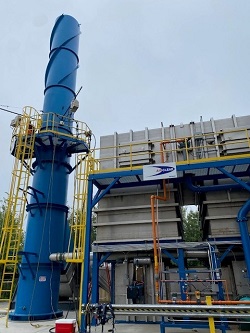Saint-Gobain Site Investigation History
The detection of PFOA in the public water supply in 2016 prompted the investigation.
Perfluorooctanoic acid (PFOA) was first detected in a tap water sample at the Saint-Gobain Performance Plastics facility at 701 Daniel Webster Highway in Merrimack, NH, in 2016, but as far back as 1986 a company called Chemfab operated fabric coating and cast-film equipment there, using PFOA and other PFAS. Saint-Gobain purchased the facility in 2002 and continued to manufacture coated textiles and films using chemical dispersions that contained PFOA and other PFAS. The manufacturing of coated textiles at the facility involves dipping fabric into a mix of chemicals (called aqueous dispersions) and then drying or curing the fabric in tall, specially designed ovens. Prior to 2021, exhaust from the ovens passed through a network of ducts before release to the atmosphere through several stacks located on the roof.
Air Emissions History
In 2004, Saint-Gobain conducted stack tests using testing and analytical methods that had recently been developed to evaluate the potential PFOA emissions from three coating towers at the facility. Upon review of the emissions detected, Saint-Gobain reported to NHDES that the emissions from the entire facility were predicted to exceed the ambient air limits (AALs) established in Env-A 1400, Regulated Toxic Air Pollutants. NHDES issued an Administrative Order by Consent to Saint-Gobain, which required reformulation of coatings to reduce PFOA content by the end of 2006. Additional stack testing was conducted in 2007, at which time Saint-Gobain demonstrated compliance with the AALs using the information from the stack test and air dispersion modeling. As a result, PFOA emissions were reduced by more than 96% from 2004 levels.
Emission Controls and Current Status

In 2018, the New Hampshire Legislature passed legislation that added Section RSA 125-C:10-e to the Air Pollution Control statute. As a result, NHDES made a determination that Saint-Gobain was subject to the regulation and required to install Best Available Control Technology for PFAS emissions. After a year-long permitting process, NHDES issued a permit for the construction, installation and operation of a Regenerative Thermal Oxidizer (RTO) for the control of PFAS with specific emission limitations for PFOA and PFOS – the two PFAS that had AGQS standards at the time of permit issuance. Saint-Gobain failed to complete the construction by the February 2021 deadline required by statute and permit. NHDES and Saint-Gobain entered into a Consent Decree in 2021, which required Saint-Gobain to complete construction and installation of the RTO by July 31, 2021, conduct more extensive stack testing, a material balance to determine potential hydrogen fluoride emission rates and conduct an Env-A 1400 compliance demonstration, and a rainwater study as well as limit operations and pay a penalty. The RTO was brought online July 14, 2021.
In September 2021, Saint-Gobain, in conjunction with their consultant Barr Engineering, conducted stack testing as required by the permit and Consent Decree to evaluate the operation of the RTO. During the stack test, NHDES observed that the main header associated with conveying the coating towers and auxiliary equipment exhaust streams to the RTO had been built with a bypass stack. Therefore, NHDES issued a Letter of Deficiency to Saint-Gobain on November 18, 2021. The LOD required Saint-Gobain to submit, among other information, a permit application requesting a significant permit amendment to Temporary Permit TP-0256 regarding the bypass stack. NHDES is currently evaluating the information contained in both the significant permit amendment application along with the state permit to operate application submitted on June 1, 2022. Saint-Gobain operates the RTO in accordance with the revised monitoring plan submitted to and approved by NHDES. Stack testing was conducted at Saint-Gobain on August 24 and 25, 2022. NHDES had two experienced staff members present to observe the method in which samples were collected and the operation of the towers at the facility during the stack test. The RTO did not encounter any issues and the stack test was completed as designed. NHDES received a final stack test report from Saint-Gobain on October 24, 2022.
Ambient Groundwater Quality Standards
In 2016, the U.S. Environmental Protection Agency (EPA) established a long-term health advisory level for PFOA and PFOS, either individually or combined, of 70 parts-per-trillion (ppt). Parts-per-trillion is equivalent to nanograms per liter (ng/L). Under emergency rulemaking, NHDES adopted the 70 ppt health advisory as an enforceable Ambient Groundwater Quality Standard (AGQS). By 2018, numerous water supply wells were identified that exceeded the 70 ppt AGQS, and Saint-Gobain connected some of the affected households to public water. In March 2018, NHDES and Saint-Gobain entered into a Consent Decree that identified an area (called the "Pre-GMZ" or Pre-Groundwater Management Zone) that encompassed the wells that exceeded the AGQS of 70 ppt and formalized a path to provide the remaining known impacted well owners with a permanent remedy, which was primarily extension of public water to hundreds of affected homes.
New state AGQS and Maximum Contaminant Levels (MCLs) for PFAS went into effect in September 2019 that lowered the allowable amount of PFOA in groundwater to 12 ppt (and set individual limits for PFOS, PFHxS and PFNA). The lowering of the AGQS resulted in the need for expanded drinking water monitoring and additional alternate water remedies across the site within the Outer Boundary of the 2018 Consent Decree.
Site Investigation Activities
NHDES received two reports in 2019 prepared by Golder Associates, Inc. on behalf of Saint-Gobain that summarized results of investigation activities at the Saint-Gobain facility that are the subject of a NHDES Comment Letter dated June 16, 2020. The Report on 2018 Stormwater and Surface Water Activities (Volume 1 and Volume 2), dated March 15, 2019, is focused on the results of stormwater and surface water sampling conducted in 2018, as well as investigation and repair of elements of the stormwater conveyance system. The Site Investigation Report, dated April 19, 2019, presents the results and findings of the site investigation. A Supplemental Site Investigation Report that summarizes additional investigation activities and presents a screening of potential remedial alternatives was submitted to NHDES on October 14, 2020. A supplemental stormwater and surface water sampling event was completed in 2022 following installation and operation of the RTO at the facility. Additional site investigation documents are available to the public on NHDES’ OneStop webpage.
Site investigation work conducted at or adjacent to the facility includes, but is not limited to:
- Installation of 50 monitoring wells.
- Collection and analysis of approximately 500 groundwater samples.
- Collection of analysis of more than 100 soil samples.
- Collection and analysis of approximately 190 stormwater and surface water samples.
- Collection and analysis of fish tissue samples.
NHDES completed a review of the site investigation documents and provided comment in a letter to Saint-Gobain dated April 28, 2022. This letter requested that Saint-Gobain submit an Application for Groundwater Management Permit (GMP) that establishes a Groundwater Management Zone (GMZ) and develops a long-term monitoring plan for groundwater at the site and residential properties that have been impacted by Saint-Gobain operations. In response to this request, Saint-Gobain proposed to collect a second set of samples from residential water supply wells to confirm contaminant concentrations before submitting the GMP and establishing a GMZ. NHDES anticipates receiving an Application for Groundwater Management Permit in spring of 2024.
The April 28, 2022, letter to Saint-Gobain also required that Saint-Gobain submit a Remedial Action Plan (RAP) in accordance with Env-Or 606. A RAP was submitted in May 2023 and NHDES is holding ongoing discussions with Saint-Gobain regarding the RAP and to ensure implementation of a successful remedial alternative(s) at the site.
Permanent Alternate Water
Following the initial discovery of PFOA in area drinking water in 2016, NHDES launched a massive testing effort to determine the extent of the contamination. Saint-Gobain and NHDES worked cooperatively and quickly to address those properties at greatest risk, providing interim bottled water to impacted residents, and point of use treatment systems, point of entry treatment (POET) systems, or waterline connections to over 500 properties, primarily in Litchfield and Merrimack. The 2018 Consent Decree between the NHDES and Saint-Gobain memorialized the responsibilities with respect to the work already completed and providing waterline connections to an additional 302 properties.
With the lowering of the state AGQS and MCLs for PFAS in September 2019, NHDES directed Saint-Gobain to commence an extensive well sampling program that expanded outward from the facility. Since that time, the sampling program has identified more than 1,000 additional properties that have tested above the current drinking water standard and have subsequently been offered bottled water by Saint-Gobain. In April and June 2022, the NHDES entered into an agreement with Saint-Gobain to provide alternate water to more than 1,100 impacted properties. The agreements outlined the framework for Saint-Gobain to provide safe drinking water, which includes connections to municipal water systems at 529 properties and POET systems at 605 properties.
During the summer of 2022, Saint-Gobain started coordinating work for municipal water connections and the installation of POET systems. Saint-Gobain began installing POET systems in December of 2022 and anticipates that the installation effort will be complete before the end of 2023. Work associated with municipal water, including construction of new water mains and connections to existing infrastructure, has proceeded since the April and June 2022 agreements. Design work for waterline extensions to the Hillcrest Road area of Litchfield was completed in the spring of 2023 and construction for this work is anticipated to begin in fall 2023, with substantial completion during the winter of 2023/2024. Construction for municipal water connections throughout Bedford and Merrimack, and waterline extensions in Merrimack, is anticipated to begin in fall 2023 and spring 2024. A potential waterline extension for areas of northern Londonderry is still being evaluated.
Investigations at and around the Saint-Gobain facility continue. As drinking water sampling identifies properties with exceedances of the state’s AGQS, bottled water will continue to be immediately provided along with proposed alternate water remedies for these properties impacted by the release of PFAS from Saint-Gobain.



